‘Behemoth’ is a word which springs to mind or, perhaps more nautically, ‘leviathan’.

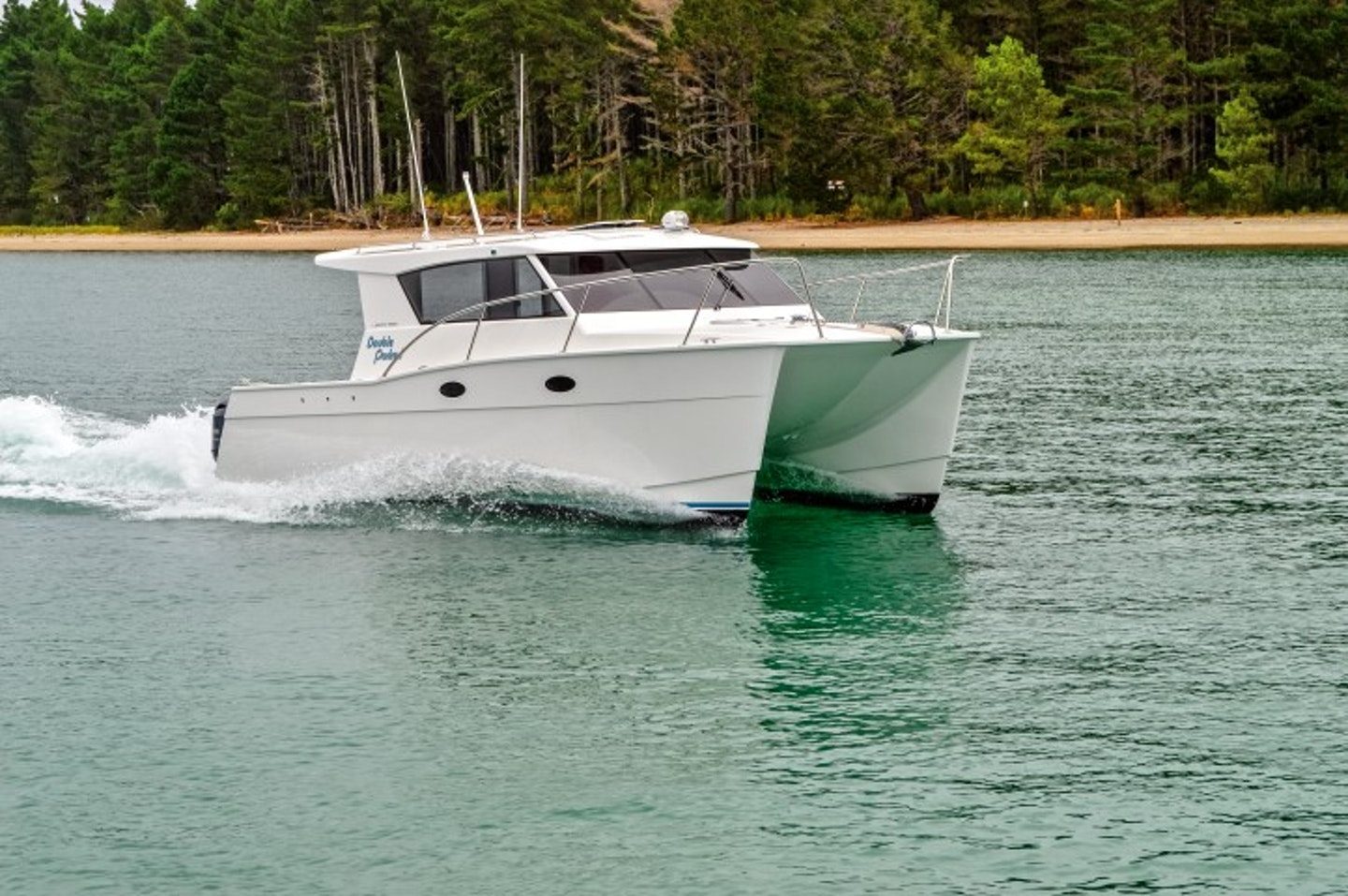
Perhaps it’s the seaworthiness, the economy – or perhaps the indoor-outdoor flow of the accommodation that suits our climate? Whatever – there is something about a displacement power cat that suits New Zealand conditions.
When good design meets meticulous boatbuilding and finish you have something special. In fact, as they say, you become ‘double-parked.’
The meticulous bit belongs firmly to sailor, sailmaker and self-taught boatbuilder, Bob de Fluiter – and his wife Sally who’ve spent five years part-time building their umpteenth boat.
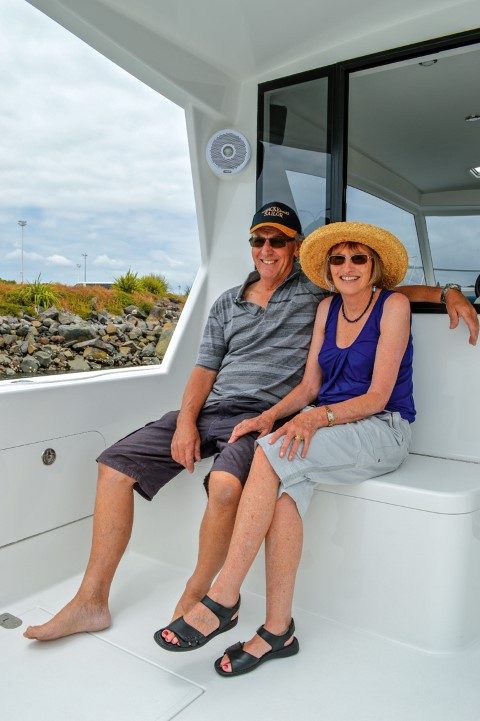
Describing the L925 Double Parked as a home-build-garage-project is misleading. The garage bit is correct, but the build is nothing less than immaculate and would put most professionals to shame.
“Originally we started with the L825 and I asked Dan to extend it and modify the design. Dan suggested it was easier to design a new boat and it was this idea that gave us the L925.” The new design was not only longer, but also significantly wider with a 3.4m beam – in keeping with the intended marina berth storage.
Construction
As is the nature of home boatbuilding, the main criteria for Double Parked’s final form was the size of Bob and Sally’s Tauranga garage. With just enough room to get around the hull, the restricted height meant that the cabin was built as a separate structure and fitted to the hull outside the garage.
As a part-time project, the construction of Double Parked took around 4,000 hours over five years, working weekends with plenty of time off for visits to grandchildren.
The files for the CNC cutouts were printed at the local furniture manufacturing factory and resulted in two trailer loads of panels delivered to the suburban garage. This kitset style system simplifies the construction and speeds up build time, but still allows for the finish of pricier production, high-end GRP and maintains the underlying strength and stiffness of composite construction.
Double Parked’s hulls are constructed of 12mm marine ply with an epoxy e glass laminate inside and out. This is reinforced with 12mm frames and 12mm doublers in load-bearing areas.
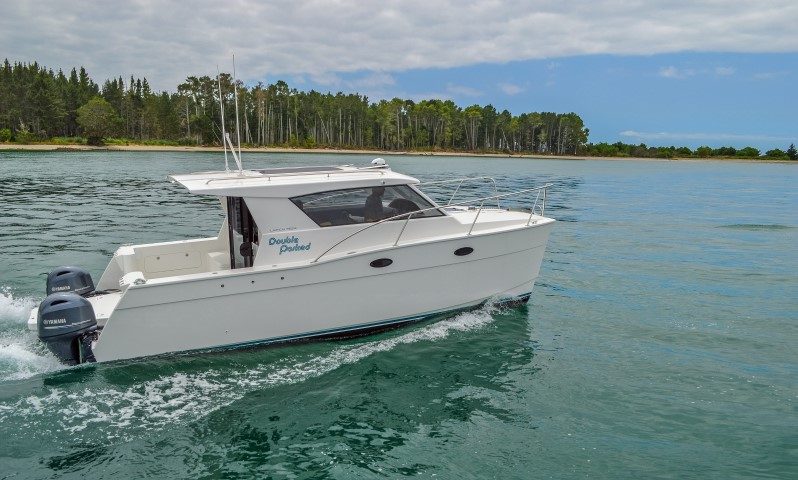
She has a 9mm pilothouse and 48mm ply/foam/ply sandwich cockpit sole, and all decks have an epoxy e glass laminate as well. There are strong collision bulkheads in the bow and deep bilges to keep any water that does come aboard away from the interior.
The hull form is a flat U with chines at the stern tapering into a tight U at the stem, strengthened by the use of a twin chine/strake format which keeps the spray deflected down and offers rigidity and more beam up high where it’s needed.
Having built many yachts, Bob was keen to keep the weight out of hull where possible and this philosophy has proven to
provide a stiff and light platform, which sits nicely on the water.
The accuracy of the CNC and the strength of the international epoxy system has meant there is not a fastening in the structure of the Double Parked, little waste timber and only basic power tools required in the build.

With a thin waterline beam on the hulls, the resistance is kept to a minimum and is more often a feature of performance sailing multihulls than of power cats. On the water, this means that it takes very little horsepower to get Double Parked moving.
Layout
Displacement power cats work well when the hulls are narrow and the bridge decks high. Dan has incorporated some eye-pleasing lines into this basic concept that give Double Parked handsome looks.
She has a reverse sheer in the forward sections accented by a spray chine that runs the length of each hull and terminates at the bows with a step, thus achieving good interior room with a dry ride. The reverse sheer gunwale allows full standing headroom throughout the interior, and also allows the pilothouse to integrate nicely with the steep sides of the hull.
The narrow hulls not only give low-drag efficiency to Double Parked’s underwater profile but also allow ample storage space under the floors. The bridge deck has substantial clearance above the waterline at the aft end, which avoids any potential pounding and gets the deck up high and away from the spray. The cat’s pleasing lines are enhanced by a quality paint job in Altex Pro Spray, making an impressive statement on the water.
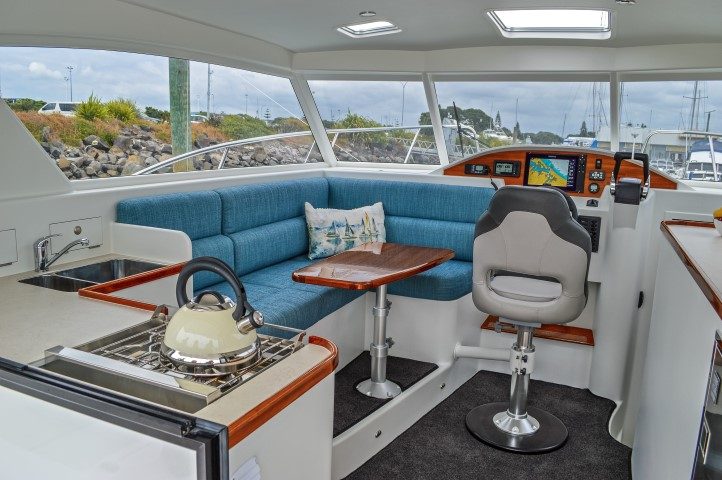
Standing on the aft wet deck/duck board there is ample room for fishing or diving from between the outboards. With the addition of a well-hidden stainless steel fold-down boarding ladder, the aft deck can also function as a comfortable swimming platform and dinghy launching ramp, allowing the main cockpit to remain clear and dry.
Under the cockpit floor are the two 150-litre fuel tanks and massive storage areas. In fact, storage around the whole boat is staggering. With a place to hide everything, it is easy to keep the accommodation clutter-free.
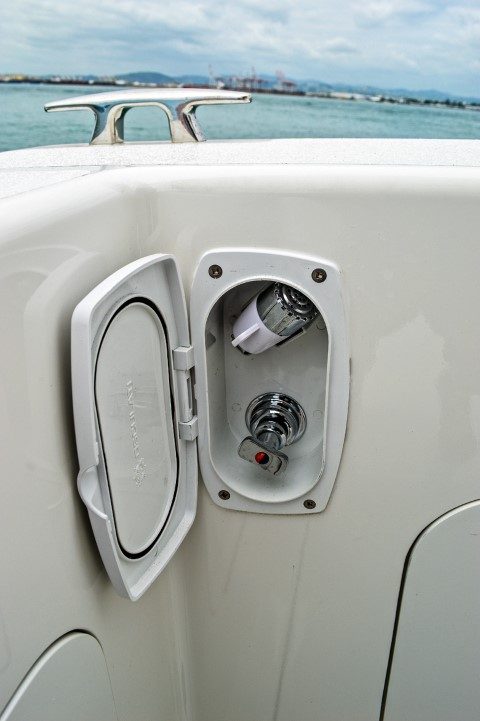
The extra beam compared to the smaller L825 means there is exponentially more space in the living areas. This is most apparent in the self-draining aft deck, which has a spacious uncluttered feeling, leading nicely into the main saloon with a small lip to keep any boarding seas out.
Folding doors open along the entire aft face of the saloon, allowing the deck and living space to combine into a spacious multi-function living area with a settee to port and nice L-shaped galley with Force-10 oven and hob at the aft end.
With the height above the water and the clever use of the tinted, strengthened glass windows set in a custom-designed frame from SeaMac Aluminium, the view from the saloon is unobstructed.
The substantial saloon area is complemented by a private and well-proportioned accommodation area with access to a king-size double bunk and substantial heads and shower all to starboard down some elegantly-built curved stairs.
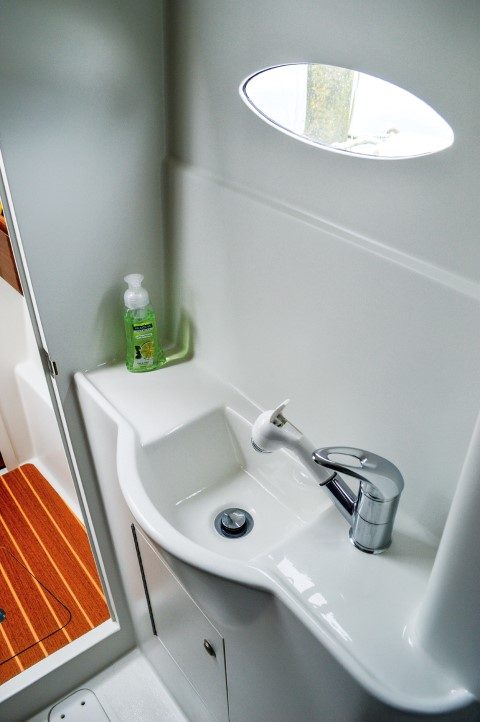
For a boat with so much room, the accommodation shows great restraint. Bob and Sally have no desire to drag around accommodation for guests who aren’t there most of the time.
“Many of our friends have their own boats and if the grandchildren come to stay we can easily accommodate them on the settee with a small footlocker to lengthen the athwartships berth,” says Bob.
The helm station is a central stand-up or sit-down arrangement with provision to remove the seat entirely if desired. There is excellent 360o visibility from the helm position helped by the raised height of the bridge above the waterline.
The instrument panel contains a simple and effective layout dominated by the 12-inch Simrad chart-plotter with easy access to the ICOM VHF, the Yamaha engine controls and the Maxwell anchor control.
This is all powered from a dedicated house battery locker on the starboard side of the cockpit and fed through a breaker panel in the cabin and topped up by two 135-watt solar panels on the cabin roof. This makes Double Parked independent of shore power.

Twin Yamaha 90hp four-strokes spin 14×12-inch props and provide more than enough power to push the low-drag hulls to the 17 knots cruising speed quickly, without a large wake. In marina mode, the engines can be tilted out of the water to avoid the hassle of antifouling.
On the Water
The first impression of L925 is of space. It is hard to believe you are on a 9.25m boat – it feels more like a 12m boat. The space is largely a function of the width and because of that, there is a real sure-footed stability that is present at the dock and underway.
Closer examination reveals some clever build solutions to the base design. Walking through the boat every corner angle and detail has been considered. This functionality is achieved by keeping the berths and toilet facilities on a lower level, while the helm, galley and socialising areas are up high in the saloon.
This separation of space works well, offering a private retreat that is essential to good morale while cruising. Opening up the aft end of the saloon to the deck creates a spacious living area. Most launches of this length are only sophisticated day boats – you get the feeling that Double Parked could take you cruising for weeks.

Manoeuvring away from the wharf or marina is a helm-free affair; the twin throttles on widely-spaced engines provide excellent control. Once out in the channel acceleration is smooth. Up high on the bridge deck there is little sensation of speed and, for the uninitiated, a constant consultation with the GPS is required to believe you are moving at all!
Double Parked tracks like she’s on rails. With the hulls doing the steering it is easy to let go of the wheel to tend to other details. Any spray from the hulls is deflected downwards so the on-deck experience is dry.
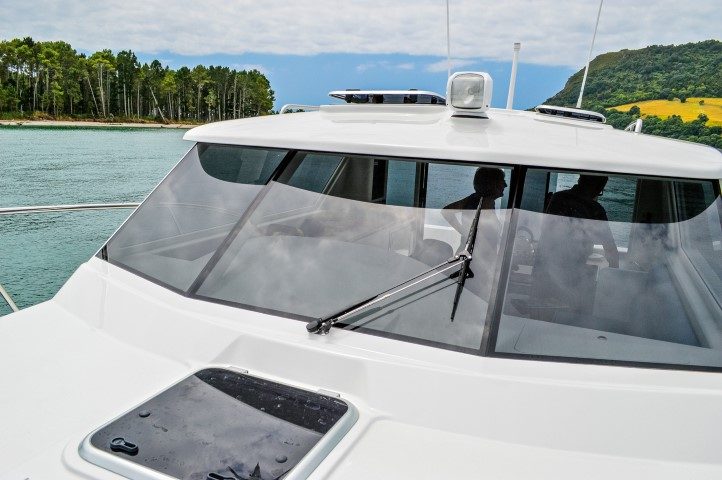
Around the corners Double Parked has a slight outward roll, keeping her feet nicely and pulling some smooth curves in the process. Flat-out at 5,500rpm, she reaches just over 22 knots. At a more sedate 3,800rpm she sits on 16 knots, consuming 25 litres an hour. At this pace, she could go all day.
As we pointed the bows towards the heads of Tauranga Harbour we were met with a small leftover roll. It was here one of the other great features of the displacement power cat platform made itself apparent. In conditions that would have started a planing hull slamming there was nothing but a soft cushion feel to the boat as she dropped off the back of each wave. This bodes well for Double Parked’s ability to get home when it cuts up rough.

Perhaps the best indication of a good boat review is when the boat reviewer stops worrying about the boat and starts relaxing and yarning. Double Parked oozes effortlessness and had me swapping tales with Bob and Sally all the way back to the marina.
While we were talking about the pros and cons of boat designs and scallywags we know, Double Parked did the work efficiently, economically and stylishly.[/caption]
‘Behemoth’ is a word which springs to mind or, perhaps more nautically, ‘leviathan’.
White Pointer has earned the respect of discerning customers in New Zealand and Australia, attracting a loyal and ever growing following for its high-quality, rugged and totally dependable aluminium trailer boats.
The hardtop SP635 shares the same underpinnings as the popular SF 635 which was a completely new model back in 2020.
The pride and joy of a multi-generational family, Bliss resides on a pier that’s home to a couple of other Elite motor launches – Sandspit Marina is a hot-spot for the Bill Upfold-designed vessels, with several calling this small marina home.